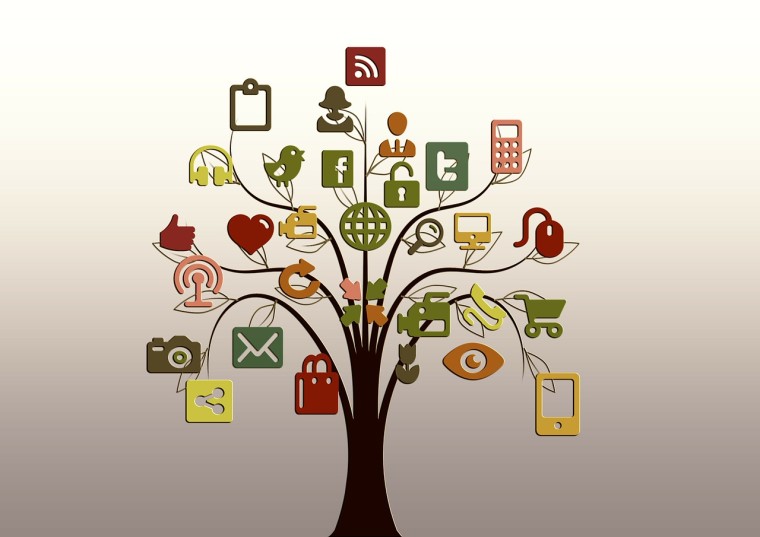If you pay attention to industry buzzwords you may have come across something called adaptive content. In its most basic definition, adaptive content can be described as an idea that is repurposed and reused over and over again. Think of a character like Frankenstein. The character first appeared in a novel, then became a movie adaptation, and has since appeared in comic books, radio programs, and TV serials.
When it comes to marketing what starts as a tweet can be turned into a blog post, an e-book, a podcast, a YouTube video, a PowerPoint presentation – the list goes on and on.
Of course, there’s a little bit more to adaptive content than that basic definition. Noz Urbina states on Content Marketing Institute that, “Adaptive content is a content strategy technique designed to support meaningful, personalized, interactions across all channels.” Or, as Demian Farnworth states on Copyblogger, “It’s almost like choosing your adventure.”
 Image Source: Pixabay
Image Source: PixabayKaren McGrane adds that adaptive content should also include the following elements:
- Reusable Content: content that is used on multiple platforms
- Structured Content: small chunks of content which can adapt to other devices
- Presentation-Independent Content: raw content
- Meaningful Metadata: data that describes how content is being used
- Usable CMS Interfaces: a system that puts this all together
For example, think about the process of purchasing an airline ticket or booking a hotel room. You probably go to the site of your preferred airline or hotel and check out prices. But, where are going to book your flight or room? Most likely a third-party site like Expedia, Orbitz, or Kayak. Instead of that, the airline or hotel should provide some sort of incentive for you to stay or book directly with them – a discount, upgrade or just about anything to make your experience more meaningful.
Why is this such a big deal?
When 94% of businesses realize that personalization has attributed to their success, you can see the sense of urgency for adaptive content.
In short, those who embrace the concept of adaptive content will get more value out of their content marketing efforts. And, here are five ways you can use adaptive content.
Give Your Content Direction
So, you have made the decision to use digital content to enhance your business marketing efforts. While this is a great way to generate traffic to your website, you should also analyze the purpose of your content and develop a strategy that prepares your content so it becomes an effective marketing tool.
The first step in formulating your content strategy is to identify your potential audience. Work to determine who is most likely to read your content and what specific information they may be seeking. Your next step will be to calculate how your goals may be achieved by catering to the needs of your content readers.
Always be sure to give your content purpose. No matter how well your content may be written, your content will have no value unless it gives the reader what they need or want. Research factors such as the buying habits of your potential readers and how your product or service can help them. Design your written material to encourage readers to further investigate your website. Review the SEO value of the material to ensure it can be found on web searches.
Use care to not “over-stuff” the material with keywords – this is where a semantic keyword strategy can really become a vital component to keeping Google happy. Conduct a test launch of the content and get evaluations to gain valuable feedback on the effectiveness of your efforts to see what material can be used in an adaptive fashion.
Once you have completed this process, only then can you decide if your content is adaptable and ready to explore other opportunities to present it.
When to Adapt your Content
Now that you have fully prepared material that can be used for a number of different platforms, you have to determine when your content needs to adapt. One of the best methods to achieve this goal is to develop a set of business guidelines that will automatically signal when to adapt your content.
As with any other aspect of your business, these systems can be vital to the success or failure of any campaign. Create rules for when to re-work a successful article into a video or podcast, and also rules for when adapting content might not be the best idea for your efforts.
Where to Display Content
Is your written material going to be formatted to a blog or transformed into an e-book? Is it going to provide an explanation for an educational PowerPoint presentation? In developing the adaptability of your written material, you and your technical team must consider where the content will be displayed.
This can influence specific characteristics of the material and how well it can be adapted to different platforms. While deciding where to display given content is often one of the last processes in developing adaptable content, these factors must be considered in the beginning stages of the creative process so your content has clearly defined characteristics based on the intended media platform of presentation.
1. Adaptability is Vital
Any business must be able to adapt to a vast number of situations to achieve or sustain profitability in the competitive world of commerce. They must respond to changing demographics, decreasing or increasing activity in related industries, and the rapid advancement of technology to stay relevant in the business world.
This ability to adapt must also apply to your company’s written material. As part of the content development team, there may be times when you have to seek support from upper management. Find those members of your company who have the most to gain by contributing to the company’s written content and web presence. Their support can allow your content team the freedom to create content that can easily transform to various formats and assets.
But, let’s take this one step further by making sure you know when to adapt to certain customers and situation. Noz Urbina uses the example of visiting a winery that could use adaptive content to enhance the customer experience. If Noz were able to tell winery what his favorite wine is, the winery could send him emails or social media notifications when that bottle is released, information about food pairings, or similar products to try.
2. Always Blog
A blog idea could originate from a single entry on a social media platform like Twitter. This idea can be expanded from a few brief sentences to a blog post that conveys the information, expresses the author’s views on a given topic, and opens up a discussion for others to participate.
Attention should be given to semantic keywords in the blog title to encourage web users to click-through to the post. Maintaining a constant flow of fresh content to the blog will slowly build your user base.
Another benefit of blogs is they are relatively inexpensive and easy to setup and use. Sites such as WordPress, Tumblr, and Blogger allow users to create blogs for free and provide comprehensive instructions for use in a matter of minutes. This can be an important consideration for a business owner with a great product or service to offer, but who may lack the skills of setting up a self-hosted solution.
These blogging platforms also give the content creator a great amount of freedom in formatting their material. This gives the writer time to fine-tune the content to ensure it is quality work for optimal audience growth. Getting started with an easy-to-use platform allows the creator to focus on building their audience through their written material and act as a passive way to gain brand recognition for their business.
3. From Blog to Ebook
An established blog that has a loyal audience can be great for a business, but it also has limitations. Readers may view a blog as just a writer’s viewpoint and not as a legitimate source of information about a product or service. This is one of the reasons creating adaptable content can be such a valuable asset to converting these passive readers into leads and customers.
There are a number of software programs that allow a blog to be easily transformed to an e-book – such as Anthologize, Blog2Print, Blurb or Zinepal. These programs work well with many of the popular blogging platforms, like WordPress, and provide user-friendly instructions on creating visually stimulating pdf versions of your posts and articles. Creating these can be as easy as entering a URL of your blog post and letting the software do the rest of the work for you.
An e-book and other subscriber-based online publications have serve another purpose as well: they often require that the reader submit their email address in order to gain access to this exclusive content. Having your content transformed into a subscriber-based platform gives the business more visibility, and hopefully, generates additional sales for the advertised product or service.
These types of web-based platforms also allow the content creator to build an email list – which can then be used for future marketing campaigns. The subscriber list can also generate demographic information about your readers.
4. Take it to Tape
Your e-book is thriving and there are many returning readers. Good for you. At some point you may want to consider your next step. One idea is to convert your written content into video and audio presentations. This will give you the opportunity to engage readers more visually – as well as evoke feelings and stay relevant with the competition.
By moving into various audio and video forms of media, such as podcasts and YouTube videos, you are giving your content an even greater level of exposure and accessibility that go beyond the blog and e-book platforms.
Innovative software programs allow content authors to transform their written material into audio and video content rather easily. For example, if you use Windows, you probably know newer versions of Word come equipped with Speak. However, there are other text-to-speech software options like NaturalReader, WordTalk and DAISY. For video, you could give Wibbitz a try.
Remember, audio and video platforms allow for a greater portability on a multitude of devices. Smartphones, tablets, and other devices can help your content reach people who may not have the time to read written content, or who just prefer videos. With audio and video formats, you can also allow the creator to up-sell the content to an even wider audience, and subsequently, lead to greater sales.
5 . Be the Voice for Your Content
Your audio and video material is prepared and you’re ready to take that next step in using your adaptable content by giving presentations within your industry, such as webinars. With presentations, you can utilize written, audio and visual forms of your content – which can be combined into one amazingly powerful presentation.
Another benefit of presentations is that it allows your audience to get a complete understanding of your product or service, along with your business’s reputation.
Giving a presentation also gives your product or services a touch of humanity, establishes you as an authority figure, and makes a deeper impression upon your audience. For example, they can attach a face to your business and will better remember your company – as opposed to just reading a blog, eBook or seeing a Powerpoint presentation. Practice and the proper preparation can not only help you give an impressive presentation, it can also generate income for your company.
Always Adapt, Always Grow
The world of technology is rapidly changing. Computers, tablets, and smartphones are becoming less expensive and more technically advanced with each passing year. With technology and information so readily available, having content that remains unchanged will not enhance your business. In reality, it may even create an image of stagnation and a having a lack of innovation.
That’s why it’s important to review your content continuously, and look at what your competitors are doing. Who knows? You may discover a new marketing technique. Furthermore, learn all aspects of creating fully adaptable content. You can then use these skills to improve your relationship with your current customers and gain new consumers along the way. But, you can only achieve this by creating experiences specially created with each customer in mind.
Featured Image Source: Pixabay




